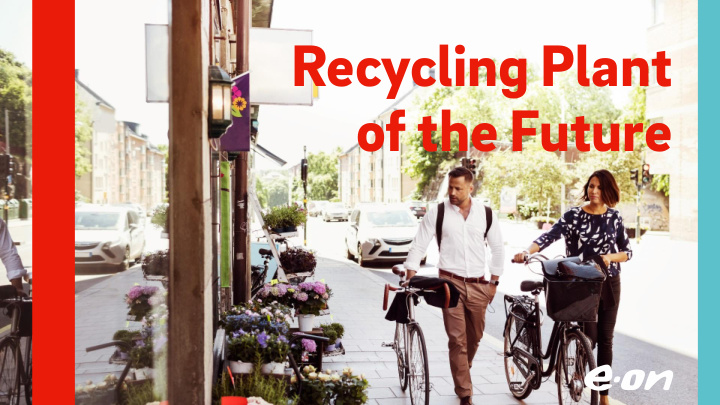



Recycling Plant of the Future
We are building a recycling plant in Högbytorp, where we will be integrating material and energy recovery in a unique, efficient and sustainable way, generating electricity, heat, biogas and bio-fertiliser from waste products.
Why building in Högbytorp? Stockholm is one of Europe’s fastest growing metropolitan regions. On average, the region’s population grows by 34 400 people per year*. More people mean more energy consumption and more waste. With the recycling plant in Högbytorp, we contribute to a sustainable growth by transforming something nobody wants – waste – into something everybody wants – energy and nutrients. *Source: Stockholms läns landsting (https://www.sll.se/verksamhet/Regional- utveckling/Nyheter/2018/11/lanets-befolkning-okar-med-en-miljon-till-2060/)
This is H his is Högb ögbytorp ytorp The recycling plant, which consists of a biogas plant and a combined heat and power plant (CHP), has a strategic location in Högbytorp, northwest of Stockholm. We’re focusing on Högbytorp both costumer’s requirements and societal needs when we provide the basis for the next generation’s sustainable system solutions. Stockholm city center Facts Total investment: 265 million euros Total annual production of energy: 650 GWh Total annual production of bio-fertiliser: 60 000 tonnes Map Stockholms län
Högb ögbytorp ytorp in figures in figures At the recycling plant at Högbytorp, the annual production of energy is 650 GWh, of which: • heating: 425 GWh • generation of electricity: 165 GWh • biogas: 60 GWh This corresponds to: • the annual consumption of heat in 21,200 average houses • the annual consumption of electricity in 66,000 normal-sized apartments • fuel to 100 million kilometers by gas car
”The world’s resources are under enormous pressure. We need to move forward in a sustainable way to make sure that there will be sufficient resources for the planet’s increasing population. Everything that is produced must be re-used several times. Ideally, nothing should be wasted. A circular economy – that is what the recycling plant in Högbytorp is about .” Stefan Håkansson, Director Global City Solutions, E.ON SE
The waste hierarchy The waste hierarchy, which has been decided by the EU, sets out the priority order for managing waste materials based on their environmental impacts.
A circular economy, what is that? In a circular economy, the lifespan of products is prolonged as long as possible, and waste is transformed into valuable resources. In the recycling plant in Högbytorp we integrate material and energy recovery, and rejected residual products are converted into electricity, heating and biogas.
The combined heat and power plant (CHP) A CHP plant produces electricity and heat at the same time. In the CHP at Högbytorp the energy from the waste will be put to efficient use. This is how it works: 1. The fuel, which consists of rejected residual products, makes water boil and produce steam. 2. The steam drives a turbine that operates a generator which creates into electric power. 3. The electricity is fed onto the electricity network. 4. The remaining heat in the steam heats the water in the district heating network. 5. Cool water is then circulated back and the process starts again.
Organic waste becomes biogas and biofertiliser Organic food The biogas plant in Högbytorp Manure and residues Organic waste transforms food waste and other organic waste into biogas, a renewable Forest Agriculture alternative to petrol and diesel. Biogas contributes to reducing the amount of Biogas carbon dioxide emission from vehicles. Bio-fertiliser In the production of biogas, bio- fertiliser, which can be used to enrich Biogas (fuel) the soil in ecological or conventional agriculture, is also produced.
Biogas production in The collected waste is pre-treated by opening packages and making Högbytorp the organic material available. The material is then slowly transported into three digesters. The biogas plant in Högbytorp is able to process 75 000 tons of material/year. Types of substrate expected to be treated at Högbytorp (approximately) Food industry Industrial waste Horse manure Waste from parks Food waste and gardens
Did y Did you kno ou know w that… … a bag of household food waste can produce enough energy to fuel a car for 3 kilometers? … by replacing petrol with E.ON’s Biogas 100, you decrease your carbon dioxide emissions by 90 percent? … bio -fertiliser replaces mineral fertiliser, hence reducing the need of virgin phosphorous? … thanks to a certification*, bio -fertiliser can be used in organic farming? *www.biogodsel.se
A smart district heating network In addition to the recycling plant in Högbytorp, we are building an approx. 25 km long district heating line that connects our grids in Upplands-Bro and Järfälla. With a joint grid we can phase out older district heating plants. The new grid can both provide heat and receive deliveries from customers who produce their own energy – so-called prosumers.
We We will soon will soon be r be ready eady In 2020, the Högbytorp recycling plant will be fully operational. We will then be equipped with a climate-smart energy and resource solution in one of the fastest growing regions in Sweden – an important step towards a more sustainable future. For more information, visit eon.se/hogbytorp
Recommend
More recommend